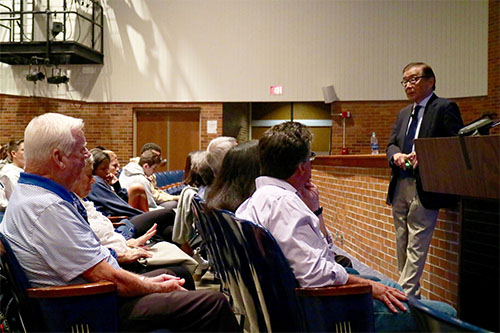Guest speaker shares experiences in internment camp

MEMORABLE MIHARA: Speaking to South students, Sam Mihara, a first-generation American with Japanese ancestry, informs others about his experiences in a World Warr II Japanese internment camp. Mihara visited South on Sept. 13 for this special address. Photo courtesy of Tara Thorne
October 6, 2017
Sam Mihara, a first-generation American with Japanese ancestry who was in an internment camp during WWII, came to speak to the GBS U.S. History classes on Sept. 13.
Mihara was born in San Francisco in the early 1930’s and was raised by his parents, who had immigrated to the United States from Japan in the 1920’s. At the start of WWII, Mihara and his family were transferred to a detention camp in Pomona, CA, and later to a prison camp in Northern Wyoming, where they remained for three years, according to sammihara.com. Daniel Rhoades, social studies teacher, described Mihara’s presentation as a blend of history and current events.
“Mihara did a really nice job of talking us through his own experiences of the Japanese internment during WWII and also making some connections to what he sees as major issues facing us in terms of civil liberties today,” Rhoades said. “I really enjoyed the way he drew parallels from his childhood experiences all the way through to the present, the most poignant of which was how he met his wife.”
Stacy Flannery, social studies teacher, also thought the story of how Mihara met his wife was a powerful element of the presentation.
“He used some photos that [depression-era American photographer] Dorothea Lange had taken and one of the photos, a very famous photo, was a young girl with her hand on her chest saying the pledge of allegiance,” Flannery said. “He used these photos in the beginning of his presentation, and at the end of the presentation, we found out that [the girl] is his wife. It was one of those cool moments to see that these people who make up iconic images in history have real lives.”
According to junior Delaney Gallagher, Mihara spent time discussing the harsh conditions he was exposed to at the internment camp.
“He talked about how his whole family lived in [about] 20 square feet,” Gallagher said.
Junior Trinity Nelson elaborated on these conditions, focusing on the food at the camp.
“They were given food that was unfamiliar to them like bread and different vegetables,” Nelson said. “[Mihara] said this was hard to adjust to because he was used to eating fish and rice.”
According to sammihara.com, Mihara attended Lick Wilmerding High School after his release from the internment camp and then graduated from University of California, Berkeley, and University of California, Los Angeles, with engineering degrees. Nelson said that Mihara also spent a lot of time describing these post war experiences.
“He discussed how hard he and his friends had to work because […] there was still racism after [WWII],” Nelson said. “People’s thoughts are not going to change […but Mihara] focused on his education and I think that is what […] got him to where he is today as a successful engineer.”
Rhoades explained that although the U.S. history classes do not learn about World War II until later in the year, the presentation applies to the year-long themes that the course focuses on.
“[We] spend a lot of time talking about civil liberties, constitutional freedoms and moments in the past […and] when those have been diminished or denied based on someone’s gender, their ethnicity, their race, [or] their socio-economic status,” Rhoades said. “Mihara’s examples and his story fit into those narratives really well.”
According to Gallagher, it is important to study events where civil liberties were violated to understand the importance of human rights.
“We can’t put security over the rights of other people,” Gallagher said. “Another [event] like the Japanese internment camps will happen if we don’t actually care about those around us.”
Mihara elaborated on this idea that although the goal of the U.S. Constitution is to protect people from injustice, it does not always work.
“The Constitution guarantees that we have liberty, [but] we were not protected by the Supreme Court,” Mihara said. “Therefore, if it happened before, it could happen again to anyone— including you, your relatives, your friends and, especially, your children.”
According to Flannery, one of the most compelling elements of the presentation was Mihara’s success story after the war.
“It was such a powerful story of talent that could have been wasted or sent out of the country if [the Japanese-Americans] had been deported or we had not figured out eventually that this was not American and the wrong thing to do to these people,” Flannery said. “The contributions that some of [them] went on to make after these camps were closed is a powerful testimony to the value of diversity to our society. […] When we take people’s humanity away, we might be taking away really important contributions to our society.”


